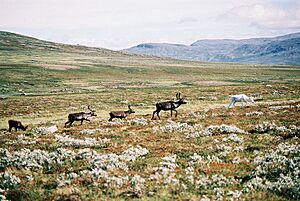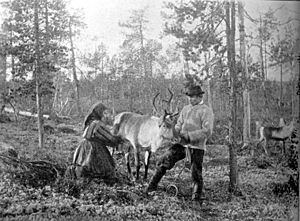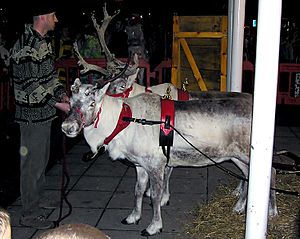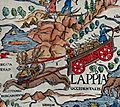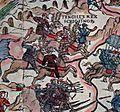Reindeer facts for kids
Quick facts for kids Reindeer(Caribou) |
|
|---|---|
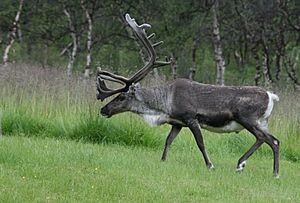 |
|
| A reindeer in Norway | |
| Conservation status | |
| Scientific classification | |
| Species | |
|
See text, traditionally 1, but possibly up to 6 |
|
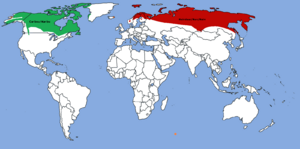 |
|
| Reindeer range: North American (green), Eurasian (red), and Alaskan introduced (orange) |
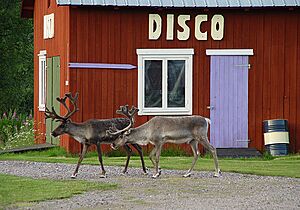
The reindeer (Rangifer tarandus) is a type of deer that has hoofs with an even number of toes. It is a mammal and belongs to the deer family. In North America, this animal is also known as the caribou.
Reindeer are the only type of deer that humans have tamed and raised. There are about 10 to 20 different kinds of reindeer, called subspecies. Even though there are many reindeer in total, some types are becoming fewer in number. Because of this, they are considered vulnerable, meaning they could be at risk.
Contents
What Reindeer Look Like
Different kinds of reindeer have different sizes and slightly different fur colors. Male reindeer are usually bigger and heavier than females. Reindeer can be about 1.2 to 2.2 meters long. They stand about 0.9 to 1.4 meters tall. Their weight can range from 60 to 300 kilograms.
Most reindeer have grey-brown fur. Their fur is darker in the summer. It becomes a lighter color in the winter. Reindeer have large feet. These big feet help them walk easily on soft ground like snow or mud.
Reindeer vs. Caribou
North American Caribou and Eurasian Reindeer are the same species. However, there are some clear differences between their subspecies:
- Reindeer are most often found as tamed animals.
- They tend to stay in one area (sedentary).
- Their breeding season starts in mid-August.
- Their fur can sometimes have patches of different colors (pinto).
- Baby reindeer (calves) are born dark brown.
- They have more body fat and thicker fur.
- Their face and nose are shorter.
- Male reindeer have larger antlers than female caribou.
Caribou are usually wild animals.
- They travel long distances (migratory).
- Their breeding season starts in mid-September.
- Their fur is never pinto colored.
- Baby caribou are born light brown.
Reindeer Antlers
Reindeer are special because both male and female reindeer grow antlers. The antlers of female reindeer are smaller than those of males.
Antlers begin to grow in April. They are fully grown by Autumn. Reindeer shed their antlers each year. Male reindeer shed theirs just before Christmas. Females shed theirs later in the spring. On a large male reindeer, antlers can grow up to a centimeter every day.
Where Reindeer Live
Reindeer can be found in many northern parts of the world. They live in Lapland, which includes northern Finland, Sweden, Norway, and Russia. You can also find them all over Canada and in Siberia. Some reindeer are raised on farms in North America. People first started using reindeer for work in Lapland and Siberia.
Reindeer Homes
Reindeer live in coniferous forests. They also live in very cold, Arctic areas. The places where reindeer have lived for a long time are now being affected by global warming.
Reindeer Life Cycle
Reindeer are social animals. They live together in groups called herds. These herds can have 10 to 100 reindeer. Some herds are made up only of females, while others are only males.
Reindeer make long journeys between warm and cold seasons. For these trips, smaller groups join together. They form huge herds of up to several hundred thousand animals. Reindeer mate in October. During this time, males try to mate with as many females as possible.
What Reindeer Eat
Reindeer mostly eat grass. However, they can eat almost any other plant too. In winter, they often eat lichen, moss, and fungi. During the winter, they use their hooves to dig under the snow to find lichen.
Reindeer Reproduction
After being pregnant for about 230 days, a female reindeer gives birth to one baby. This usually happens in May or June. Unlike most other baby deer, young reindeer do not have spots on their fur. Young reindeer become adults when they are about two years old. Reindeer usually live for 12 to 15 years. Some can even live up to 20 years.
Reindeer and People
Humans have hunted reindeer since the Stone Age. People in northern regions used reindeer for their meat, fur, skin, antlers, and bones.
Reindeer were tamed by humans about 3,000 years ago. This first happened in Siberia and Scandinavia. Since then, people have also used reindeer for travel. For example, they pull sleds. Because reindeer can live in very cold climates, tamed reindeer are used in most northern parts of the world.
The Sami people in Lapland are one of the ethnic groups who use reindeer. They use them for fur and food.
Protecting Reindeer
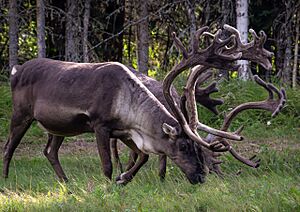
The IUCN says that Rangifer tarandus, as a whole species, is not in danger. This is because there are many of them, and they live in a wide area. However, since 2015, the IUCN has listed reindeer as Vulnerable. This is because their population has dropped by 40% in the last 25 years. Some specific types of reindeer (subspecies) are rare. Three subspecies have already become extinct.
In North America, two types of caribou, the Queen Charlotte Islands caribou and the East Greenland caribou, died out in the early 1900s. The Peary caribou is now listed as Endangered. The boreal woodland caribou is listed as Threatened. Some individual groups of caribou are also endangered. While the barren-ground caribou is not listed as Threatened, many of its herds are shrinking. This is a big worry for local communities. Grant's caribou, a small, pale type found in Alaska, has not been checked for its conservation status.
The status of the Dolphin-Union herd was changed to Endangered in 2017. In Canada, some caribou populations are classified as Endangered or Threatened. For example, the Selkirk Mountains caribou and Rocky Mountain caribou are Endangered in parts of British Columbia. Montane caribou are now gone from the contiguous United States, including Washington and Idaho.
In Eurasia, the Sakhalin reindeer is extinct. Wild reindeer on most of the Novaya Zemlya islands have been replaced by tamed reindeer. However, some wild reindeer still live on the northern islands. Many Siberian tundra reindeer herds have become smaller, some dangerously so. But the Taymir herd is still strong. In 2010, about 940,000 wild Siberian tundra reindeer were estimated to exist.
Reindeer in Popular Culture
Around the world, people become very interested in reindeer during the Christmas season. According to old stories, Santa Claus's sleigh is pulled by flying reindeer.
Rudolph is a famous reindeer. He is known for his bright red nose.
Images for kids
-
In Suomussalmi, Finland
-
Licking salt from a roadway in British Columbia
-
An early 20th century Inuit parka made of caribou skin
See also
 In Spanish: Reno para niños
In Spanish: Reno para niños





